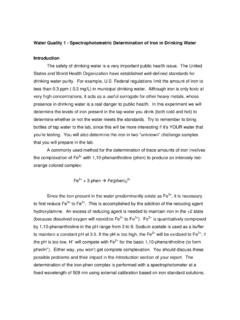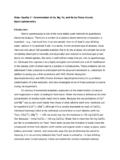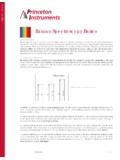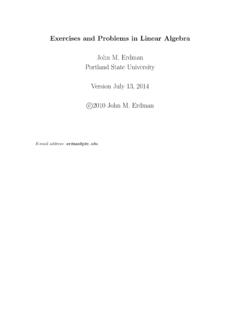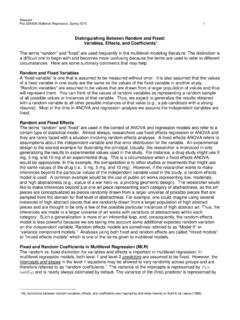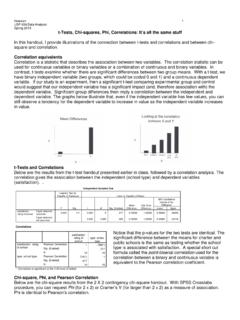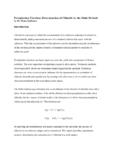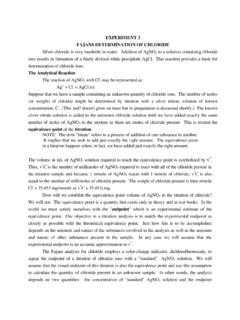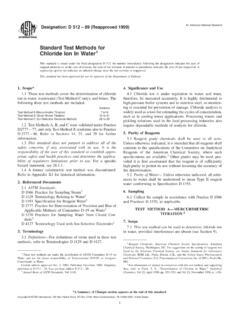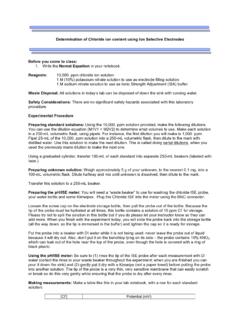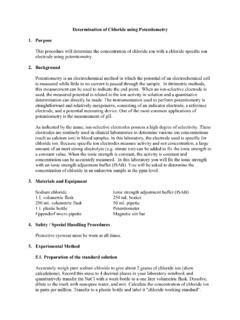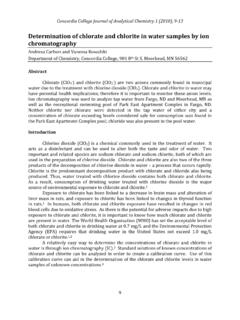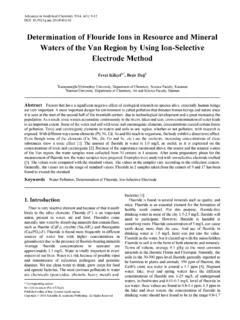Transcription of Anion Analysis 2 Determination of Chloride and Bromide ...
1 Anion Analysis 2 Determination of Chloride and Bromide with Ion- selective Electrodes Introduction Ion- selective electrodes (ISEs) are specially designed electrodes that respond selectively to a particular ionic species in a solution. Most ISEs are based on a measurement of the potential (energy) difference that develops across a semi-permeable (to the ion of interest) membrane that separates solutions with different concentrations of the analyte ion. The most familiar example is the glass electrode (the glass is semi-permeable by protons) in the pH meters that you ve used extensively in the past. In this experiment, we will use Chloride and Bromide ion- selective electrodes that respond selectively to the Chloride or Bromide ions in a solution. If the selectivity is high enough, Chloride (or Bromide ) can be determined in the presence of other ions such as Bromide ( Chloride ) and iodide that would otherwise interfere if methods such as titration or gravimetric Analysis by AgNO3 were used.
2 The response of halide ion ISEs at 298 K can be described by the equation: E = constant - ( ) log ax- (1) where E is the measured voltage, the constant takes different values for different types of electrodes, is the electromotive efficiency which should be close to for a good electrode (which we hope will be the case here), and ax- is the activity of the ions being measured (for example aCl- for the Chloride ion). Recall that the log ax- term can also be stated as pX as was done in the definition for pH. In a low ionic strength solution, the activity can be approximated as the molar concentration, ax- [X-] and they always share the same unit. The constant and will be determined in calibration procedures for the two ions. Because we usually experience non-linear calibration curves ( , E vs.)
3 PCl) in this experiment, you will use both direct (external) calibration and standard addition methods for quantitation of the unknowns and you will compare the results in your report. Apparatus 100 mL volumetric flasks (9) 250 mL volumetric flasks (3) 100 mL beakers (9) 500 L automatic pipettor (1) 10 mL pipet (1) Instrumentation (See Appendix for Operating Instructions) Accumet AB15 digital pH/ISE meter with Fisher Accumet Bromide and Chloride combination ISEs (only one probe at a time can be connected to the meter) (Note: these electrodes have integral reference electrodes and junctions.) Solutions available (1) M KNO3: measure out about 10 mL with a graduated cylinder. (2) M KNO3: measure out 50 mL with a graduated cylinder.
4 Solutions to be prepared NaCl stock solution (~ M); Accurately weigh about g (to g) of NaCl, quantitatively transfer into a 100 mL volumetric flask, dissolve in deionized water, fill to the mark, and mix thoroughly. KBr stock solution (~ M); Accurately weigh about g (to g) of KBr, quantitatively transfer into a 100 mL volumetric flask, dissolve in deionized water, fill to the mark, and mix thoroughly. Challenge unknowns : Pipet 500 L of the NaCl and KBr stock solutions into separate 250 mL volumetric flasks and then add both to a third 250 mL volumetric flask, fill all three to the marks with deionized water, and mix thoroughly. Procedure (1) Direct (or External) Calibration for Chloride a) Dilute the M NaCl stock solution as follows (serial dilution) to give a set of standards with pCI , , , , , and Dilute mL of M NaCl stock in a 100 mL volumetric flask to produce a M NaCl solution, of which mL is transferred to another 100 mL volumetric flask and diluted to make the M solution, and so on.
5 Be very careful during this series of dilutions, since the solutions will be indistinguishable and thus easy to get confused. b) To a series of dry 100 mL beakers, add mL of the standard solutions of pCI = 1 to 7 and the challenge unknown samples. Use a graduated cylinder, but measure the volume as carefully as you can. Add mL of M KNO3 solution to each solution to control the ionic strength. Immerse the Accumet Chloride ISE in each solution, measuring the voltage after a stable reading is obtained on the meter ( , no change in the reading for about one minute). c) For the standard solutions with pCI of 3 and 6, record the voltage reading on the Accumet Chloride ISE every half minute (after immersion of the electrode ) for three minutes and then every full minute for ten minutes or until a stable reading is obtained.
6 D) Construct a calibration curve with voltage vs. pCl for use in procedure (2) described below. Retain the two Chloride -containing-unknown solution beakers for the next procedure. (2) Standard Addition Method for Chloride Measure the voltage of the Chloride -only unknown using the Accumet Chloride ISE and use it to approximate the concentration of the unknowns from the direct calibration. Measure the voltage of the mixed unknown using the Accumet Chloride ISE. Add 500 L spikes of an appropriate stock sodium Chloride standard solution (a good choice is the one that is ~100x more concentrated than the unknown) to both Chloride -containing unknowns, stir well, and measure the voltages once they stabilize. {You don t need to add any additional M KNO3 because the spikes are small relative to the total solution volume.}
7 } Add a second 500 L spike to both solutions, stir, and measure the voltage. Repeat with a third, fourth, and fifth spike. (3) Bromide Measurements Repeat Procedures (1) and (2) above using the Bromide stock solution and the three unknowns with the Accumet Bromide ISE attached to the meter. Parts (b) and (c) will produce one direct calibration plot and one set of time responses (for pBr = 3 and 6) using the Accumet Bromide ISE. Use only the two Bromide -containing unknowns in the standard addition procedure. Report: In preparing the Final version of this report, you should consider/complete /discuss the following, in addition to including the subjects you covered in the Partial Report filed the first week: (1) Response curve: Plot voltage vs.
8 Time for the standard solutions with pCI and pBr of and and estimate a response time for each electrode /activity combination. Discuss any differences in response time for different activities or electrodes. What do these findings imply about the measurements that you made during the other parts of the experiment (and potentiometric methods in general)? (2) Direct calibration : Tabulate and plot the voltage vs. pCI and pBr for the direct calibration experiments. Discuss the nonlinearity, if any is observed. Find the concentration range of linear response, obtain the linear equations, and calculate the concentration of Chloride and Bromide in the challenge unknowns . Is there any evidence of cross sensitivity between Chloride and Bromide in this method ( , does the Chloride ISE respond to changes in Bromide concentration and vice versa)?
9 (3) Standard addition: Tabulate the voltage vs. volume of standard solution added for the Chloride and Bromide experiments. Calculate the concentration of Chloride and Bromide in the samples using the method described below. Be sure to include the Y vs. Vs plots in your report. Compare the concentrations of Chloride and Bromide obtained by standard addition with the ones calculated using the direct calibration curve and discuss the "matrix effect". (4) Compare the potentiometric method to the fluorescence quenching method. Discuss analytical factors such as precision, accuracy, linear dynamic range, etc. as well as more practical factors such as speed, cost, and ease of use and Analysis . Appendix: Calculations for standard addition experiment with an ion- selective electrode The calculation for the standard addition method with an ion- selective electrode is not straightforward and is described below.
10 Two equations are used: (1) the equation for potentiometric Determination of the ion, and (2) the dilution equation, as applied to your system of spikes. (1) The equation for the potentiometric Determination of CI- as plotted in the direct or external calibration method is (from Equation 1): E (mV) = a + b log aCl- = a + b log([CI-] Cl-) = a + b log [CI-] + b log Cl- = a' + b log [CI-] (at constant ionic strength, maintained by adding KNO3) where a'= a + b log Cl- and Cl- = activity coefficient of Cl- Please note a few points: 1. The potentiometric method measures the activity, not the concentration, of Cl-. 2. The slope b is a property of an ion- selective electrode ; it is determined from the direct calibration measurement and will not change with matrix in the standard addition measurement.
